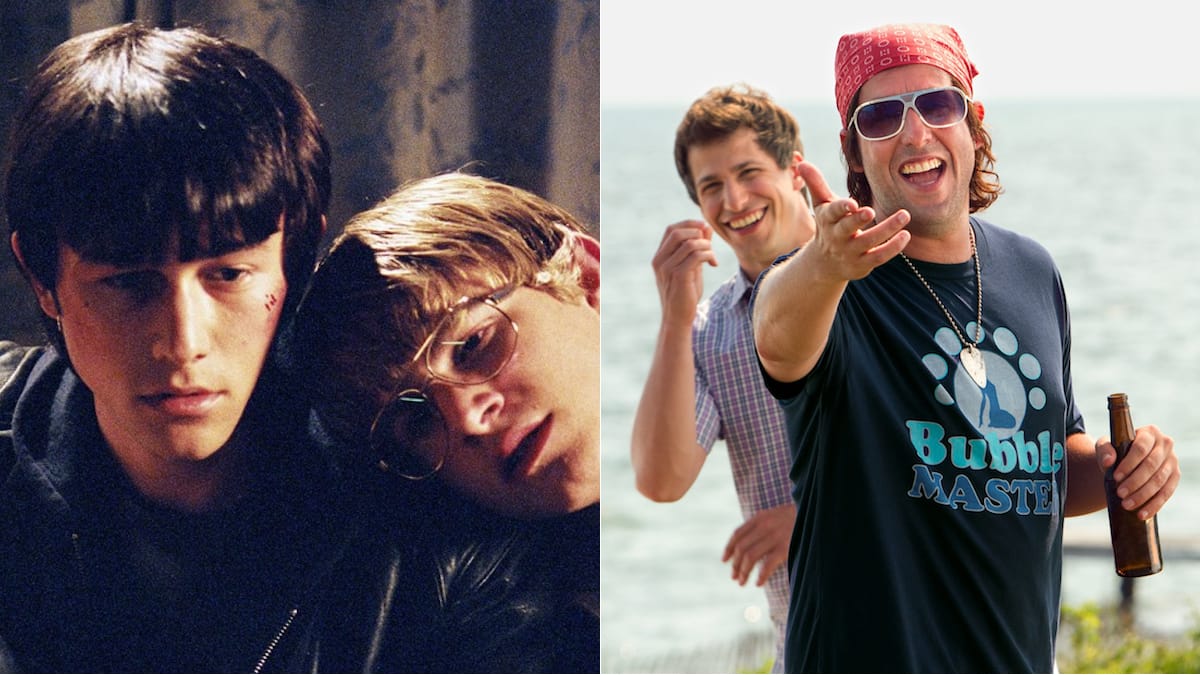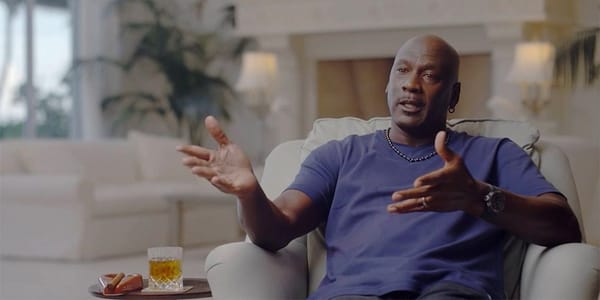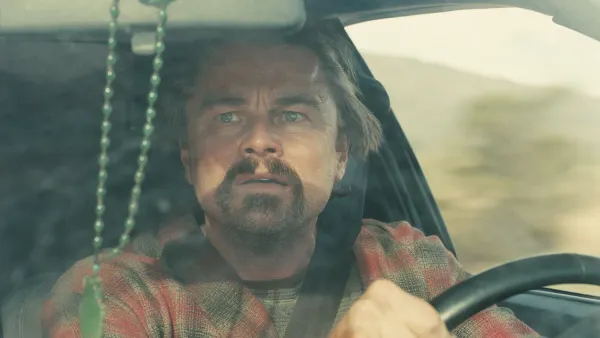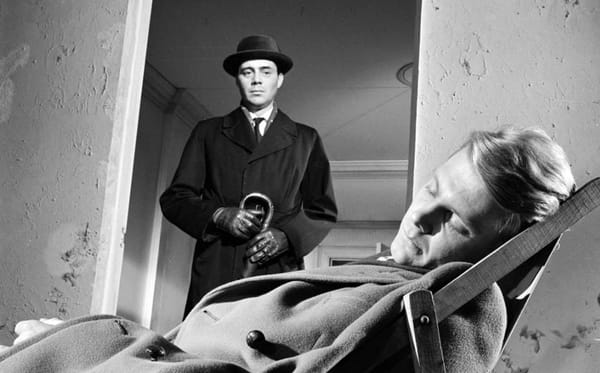‘You let me eat cake and lollipops for breakfast everyday!’

Gregg Araki's Mysterious Skin and the Adam Sandler vehicle That's My Boy are two sides of the same strange coin when it comes to the treatment of trauma on film
TW: childhood sexual abuse, rape, paedophilia
In 1980s California, Donny, a boy of no more than 12 or 13 years old, is lured into a sexual relationship with his schoolteacher. She becomes pregnant. The tryst is publicly exposed and the teacher is sentenced to thirty years in prison for statutory rape. Donny spends the next few decades leading a life of excess and debauchery, the subject of continued prurient public interest in his story. He remains unable to shake the memory and infamy of his childhood abuse.
Fast forward to the present. Broke, alcoholic and saddled with debts, Donny hopes to reconnect with his estranged son Todd, who has lived much of his adult life away from him, ashamed of his father and now on the verge of marrying into a wealthy family. But when Donny discovers a perverse secret about his son's future wife, he sets out to rescue Todd from making a terrible mistake, all the while exposing the moral and sexual hypocrisy of an adult world that has seemingly left him completely behind.
Meanwhile, in 1980s Kansas, two lonely and neglected eight year old boys, Neil and Brian, are taken under the wing of their handsome baseball coach. The coach showers them with attention, affection and the promise of sugary food, videogames and company. He then molests them and encourages them to recruit other young boys for a cycle of sexual abuse, chillingly whispering to them 'Don't ever let anyone tell you there's anything wrong with this'.
Flash forward a decade or so, and the two boys are now living very different, paralleled teenage years. Neil is a restless queer teen, hustling older gay men for money to pay his way to go to New York, all the while looking back with strange fondness on his memories of the coach. Brian, meanwhile, has completely blotted out the childhood ordeal and become a shy, introverted teen with a special interest in UFOs, a sublimation of his locked away trauma and queasiness about his own body and the alien nature of his reality. Eventually, the two young men meet again and unlock memories of their trauma together. We leave them in an uneasy embrace, both finally able to process what happened to them with a new clarity and, we hope, to move on with their lives.
Though these two film premises sound oddly alike, sharing as they do common ground in their exploration of childhood sexual abuse, the lasting marks of trauma and an uneasy reckoning with the adult world forever filtered through the prism of the past, their genres and cinematic contexts could not be more profoundly different — the first being the plot for a raunchy, R-rated sex comedy from superstar Adam Sandler, and the latter for a sensitive, acclaimed indie from festival darling Gregg Araki.
Seemingly inspired by (or, at any rate, closely echoing) a throwaway South Park joke about gendered double standards — in which baby Ike is seduced by his teacher and, upon discovering that he has been molested by his attractive female teacher, the police do not respond with horror but instead with the repeated comment 'Nice!' — Sean Anders' 2012 film That’s My Boy starts from a premise of public callousness towards, and even sleazy fascination with, an ordeal of sexual abuse involving a child.
Never letting up from a tone of nihilistic, farcical hopelessness and despair with the world, the film on its own maniacal, anything-goes comedic terms seems to share Donny’s (albeit disturbingly cheerful) feeling of disgust and contempt for the adult realm, one that is as full of hypocrisy and double standards as his childhood was. Donny is a familiar Sandler archetype, a brash drunk forever humiliating himself and others, but the stark context given for his behaviour is unusual and revealing. He is the bedraggled, tragicomic focus of an admirably horrible film, its barrel scraping humour continually offset by a looming sense of horror and sadness.
The standard formal plainness and flatness of the film’s style as well as familiar settings from Sandler’s oeuvre – the world of strip clubs, bars and saunas, contrasted with rich townhouses and lavish hotels – plus recognisable performers from Sandler movies, all take on a particularly nightmarish quality in the context of the film’s explicit depravity. Yet That’s My Boy has the honour of being amongst the worst reviewed films in Adam Sandler's chequered filmography. The film also underperformed at the box office, most likely because it was seen as too profound a tonal shift from the kind of teen and family-friendly comedies the star has historically been associated with.
Of course to appreciate Sandler’s performances in Punch Drunk Love or Uncut Gems is often to simultaneously separate them out, to distinguish them from the films that made him a star, or even to understand these prestige performances as a kind of metatextual play with Sandler’s stardom, the characters he usually plays, and his star persona. Coupled with its edgy play with a Sandler character archetype, That’s My Boy’s mix of harder subject matter, more profane language and sexuality operates on a similarly metatextual level to those lauded works, bringing to the fore themes and ideas latent in Sandler’s more critically reviled and commercially successful work. The jokes, scenarios and milieu are familiar, but pushed to more explicit and horrible extremes.
However, the standard visceral critical contempt that greeted the film tellingly reveals the extent to which a film which does not explicitly sit outside Sandler’s typical filmography - marcated as a work of auteurism, or specifically described as not a gross out comedy - will always struggle to be engaged with on any deep level. But that critical contempt also likely has much to do with a certain squeamishness around the format and positioning of its subject matter. A certain skittishness around that subject in this film is profoundly noticeable in the critical pans, especially contrasted with the enormous wealth of acclaimed indie films of apparent tonal and moral seriousness exploring strikingly similar territory and which almost always get a pass.
Modern, acclaimed US indies from Michael Cuesta’s L.I.E (2001) to Nicole Kassell’s The Woodsman (2004) and Todd Field’s Little Children (2011) have all met with fantastic acclaim, dealing — with varying degrees of salaciousness, and even sometimes crassness — with issues of childhood sexual abuse. These films typically present themselves in a mood of sombre moral seriousness and thematic weightiness, their sobriety apparently signifying the ‘authenticity’ and ‘value’ of the endeavour in the face of the horrors they dramatise. Humour — specifically gross out comedy — by contrast is apparently absolutely not the ‘tasteful’ forum in which to explore the same ideas, and attempts to do so appear condemned to indifference and contempt. Even despite and perhaps because of the film’s comparatively shrewd, unsentimental observations on the topic, its unified rollcall of grotesque characters and scenarios dramatising a world full of sexual double standards and abuse, as well as its strikingly memorable performances and nihilistic swagger, That’s My Boy is held in the lowest of critical regard.
Cut back to Gregg Araki's 2004 film Mysterious Skin and the picture could not be more different. Renowned for his punkish and anarchic low budget features about teen sexuality, rebellion and transgression, including The Living End (1992), Totally Fucked Up (1993) and The Doom Generation (1995), Araki’s films had to that point been full of eye-popping colour, breakout teen stars, vogueish music and a heady, disturbing mix of frank sex comedy and graphic violence. They had remained nonetheless comparatively confined to a festival and ‘queer film’ cinematic ghetto. Mysterious Skin by contrast, a sensitive adaptation of the superb novel by Scott Heim, was well-received as a work of new maturity, sophistication and nuance, a step towards a more adult form of filmmaking for a director always unquestioningly aligned with an indie sensibility, progressive politics and humanism. And, whilst it was certainly no massive box office breakout for Araki, the film essentially launched stars Joseph Gordon Levitt and Brady Corbet, and remains amongst the director’s best received, most revered works.
The heightened subjectivity of that film’s style, its vivid use of music (more on this here), along with its superb performances and exquisite use of framing, colour and sound, are all laudable elements in a richly emotional, superlative piece of filmmaking. And yet, considered only in terms of the rest of the director’s work, its comparative formal tameness, its classicism and narrative conventionality stand out. So to situate its revered reception and break-out status within a wider corpus of work is to understand the extent to which this most transgressive filmmaker of the New Queer cinema had to rein in his more punkish sensibility in order to be absorbed into a new tier of the indie film scene.
Returning for a moment to That’s My Boy and that film’s extremity, frankness and transgression, and the critical and audience rejection of those facets, build up a quite telling illustration of the extent to which generic boxing and positioning can affect a film’s reception. Sandler’s pushing of the Happy Maddison format into new realms of ‘tastelessness’ earned a wholesale rejection, where conversely Araki’s tempering of his own formal and thematic excess earned Mysterious Skin its position in a canon of acclaimed indies. Factor in the specific subject matter – childhood sexual abuse – and the canon of the palatable and acceptable further narrows. There are exceptions to this rule, of course. Todd Solondz’s Happiness (1998), which met with rapturous reviews and a new scale of audience for the filmmaker’s work, deals candidly and with dark humour with the subject of a paedophile and his relationship with his family. The fact that this narrative strand sits within a wider panoramic comedy about sexual hang ups and suburban fuck ups probably helps dilute that more transgressive, button-pushing element of the film. Outside of this kind of exception however, there is certainly a comparatively narrowed tonal context in which ‘legitimate’ and culturally lauded representations of childhood sexual abuse can situate themselves.
There is a telling scene towards the end of That’s My Boy in which Donny, catching his future daughter-in-law in bed with her own brother, spontaneously begins to wretch and throw-up at the spectacle. It’s the culmination of a catalogue of humiliations for Donny, including his own troubling reunion with the woman who abused him in prison, a scene in which he clearly still harbours desire and love for her and tries to reach out and touch her. Both scenes are naturally played here for grotesque and effective laughs in context. And yet their focus is remarkably similar to eerily comparable scenes in Mysterious Skin, in which Neil fantasises to memories of his abuser and one in which Brian passes out on a farm when a sense memory triggers the hazy recollection of a particularly grisly act from his repressed childhood trauma.
If the overall effect of Mysterious Skin is to intensely humanise the characters and make us feel emotion through witnessing viscerally physical acts associated with trauma, then it is hard not to feel the same in That’s My Boy, witness as we are to the intensity of Donny’s disgust. Sandler’s twitchy, grating performance takes on new meaning and richness as the mood of the film continues to darken and sour. Laughter is the expected response, but it is laughter of unease, shame and revulsion.
While both films tackle and centre a viscerally monstrous act without denying its viscerally disgusting nature, there is an undeniably more palatable aspect to Araki’s approach, his film bordering on the impressionistic at times, situating its many horrors within a wider stylised coming of age narrative full of beauty and romanticism. Sandler’s film by contrast leans into disgust, emphasises it even, showing degradation and abuse to be rampant and omnipresent in nearly all aspects of human relationships. The matter-of-fact presentation of the film’s scenes and setpieces — from a grotesque wedding rehearsal, via a debauched stag-do and its chaotic fallout — all move with a perverse comedy logic certainly, but a lack of real stylisation always returns the (all but completely irredeemable) characters to their physical reality, never allowing for anything transcendent to soften the blow of witnessing their pratfalls, their traumas or basest desires.
The two films show a world in which sexual abuse is rampant, and in which victims of abuse develop their own strategies to cope with their trauma. Both films retain a certain power and mystery. However, given the reception and context of both films, the question remains, when tackling a viscerally disgusting subject, is it more appropriate to make sombre, serious films about it, or to make work that is itself viscerally disgusting and tasteless? And will the former remain the only acceptable way to process the issue dramatically from a critical perspective, and the latter always dismissed as base and tasteless?



